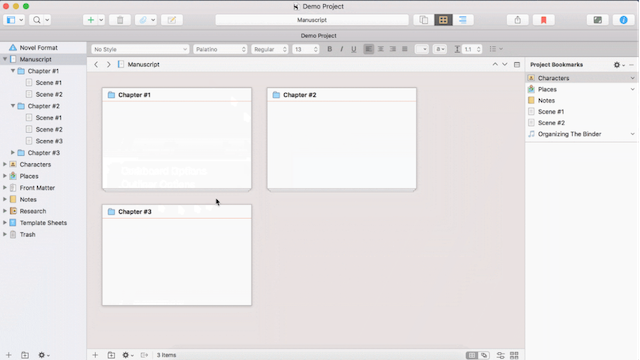

- #Scrivener windows folder corkboard how to#
- #Scrivener windows folder corkboard full#
- #Scrivener windows folder corkboard software#
You can still open a project by going to File->Open. It just means your settings/preferences are set that way. If you start Scrivener and don’t see the New Project window or an open project, that’s okay.

If you close Scrivener without closing your projects first-totally okay to do-it will open those same projects when you start it next time. You can also access the New Project window when Scrivener is open by going to File->New Project. From here, you can either create a new project or open an existing one. This window appears the first time you use Scrivener, and anytime you closed all projects before exiting the program last time (see #2). When you start Scrivener, you will see one of three things:
#Scrivener windows folder corkboard software#
If you open the file for which the default program is not already running, the computer launches the relevant software as well.) This will launch Scrivener too. (This is true of most files on your computer. There are numerous places where the icon might be: Desktop, task bar (PC), dock (Mac), Start menu (PC), Applications folder (Mac), Program Files (PC).Īnother option is to open an existing Scrivener project from your file management system (Finder on a Mac, Windows Explorer on a PC). Start Scrivener the way you’d start any program on your computer. I've realized there are a few key concepts that many users-new and old-don’t understand.
#Scrivener windows folder corkboard how to#
I figured everyone knew how to use a computer, therefore they already understood this stuff. (To customize what you see in Outline view, go to View menu > Outliner Columns.When I started teaching others how to use Scrivener, I often skipped the basics. If what you want is to see metadata (label, synopsis, status, etc.), then outline view might be what you want for the middle section (which also lets you move more seamlessly between scene and chapter (updating the right-hand editor and word count as you go). The problem is that drilling down to see the scene-level word count isn’t easy. When you click on a group in the corkboard, it will sync to the text view and let you view the word count at the bottom. Set the right-hand editor to text/Scrivenings view.

Set the center editor to corkboard view, then click on the button to sync the two editor panes. First, create a vertical split view by using the buttons in the upper right corner of the editor. I can adapt that same strategy to see word counts in corkboard mode. I have my scenes and chapters organized in the Binder and I click to different levels to see the word count at the bottom of the main editor window, which is in “Scrivenings” view (i.e., viewing the text). While I’m not positive this is what she wanted, it sounded like a helpful feature, so I tried to figure out a way to do it.įirst, I’ll show you how I do it. Never lose a great idea again! You can view or roll back to a snapshot at any time.Īuthor Kimmery Martin asked to see word counts in corkboard view for Scrivener. But what I love most is being able to capture and label specific versions of scenes, especially as I’m drafting. The whole project is automatically backed up locally (by default, whenever you close the app), and I save the project to OneDrive so that it’s also backed up in the cloud (Google Drive and DropBox, etc., would work the same). Then Chapter 1 is automatically created and titled with the name of the folder (you can specify the format, but for manuscripts I use “Chapter 1: Change in Policy”). In the picture at left, “Part 1: Setup” is a note to myself that I leave out when I compile, but if you wanted to divide your book into parts or sections, you could include them. I write my scenes first, then reorder them according to Three-Act Structure, and then group them into chapters based on length and scene ending. Create chapters automaticallyĮach “document” in Scrivener is a scene, so each folder is a chapter. For Nanowrimo, I wrote my first draft as unsorted scenes (see picture to the right). When you “compile” (turn your project into another format, such as a Word document or ePub book), scene breaks (e.g., “* * *”) are automatically added between documents.
#Scrivener windows folder corkboard full#
On Windows, View menu -> Full Screen Backdrop -> Choose… 2.


 0 kommentar(er)
0 kommentar(er)
